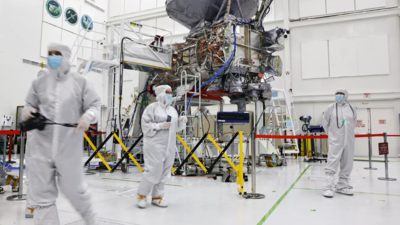- News
- Science News
- NASA unveils probe bound for Jupiter's possibly life-sustaining moon
NASA unveils probe bound for Jupiter's possibly life-sustaining moon
US space scientists unveil Nasa's mission to investigate Jupiter's moon Europa for signs of alien life. The spacecraft Clipper, set for launch in October, aims to study Europa's icy surface and assess habitable conditions. Despite challenges, scientists are optimistic about discovering potential life beyond Earth.

The NASA Europa Clipper spacecraft is viewed during a media tour inside a Spacecraft Assembly Facility clean room at Jet Propulsion Lab. (AFP)
NEW DELHI: US space scientists on Thursday revealed Nasa's upcoming mission to explore one of Jupiter's icy moons in search of extraterrestrial life. The spacecraft, named Clipper, is scheduled to launch in October towards Europa, a moon with potential for life. Bob Pappalardo, the project scientist, emphasized Nasa's quest to uncover the existence of life beyond Earth.The $5 billion probe is currently undergoing preparations at Nasa's Jet Propulsion Laboratory in California, ensuring it remains free of contaminants before its journey to Europa.
"One of the fundamental questions that Nasa wants to understand is, are we alone in the cosmos?" Bob Pappalardo told AFP.
"If we were to find the conditions for life, and then someday actually find life in a place like Europa, then that would say in our own solar system there are two examples of life: Earth and Europa," he added.
"That would be huge for understanding how common life might be throughout the universe," Pappalardo asserted.
Despite challenges such as intense radiation and communication delays, scientists remain optimistic about the mission's potential. Clipper's advanced technology will delve into Europa's environment, resembling extreme conditions on Earth where life thrives. Jordan Evans, project manager, highlighted the mission's significance in expanding the possibilities of life in the universe. The probe's solar panels face a test in powering the spacecraft efficiently amid Jupiter's distance from the Sun. The mission, initiated in the late 1990s, is projected to conclude by 2034 after fulfilling its scientific objectives.
Following the research phase, Clipper is planned to impact Jupiter's largest moon, Ganymede, for the mission's final act. Tim Larson, deputy project manager, outlined the spacecraft's disposal plan post-mission completion. The mission's focus on Europa's potential habitability showcases Nasa's commitment to exploring the vast unknowns of our solar system.
In a statement, Pappalardo expressed the mission's broader implications, saying, "If we were to find the conditions for life, and then someday actually find life in a place like Europa, then that would say in our own solar system there are two examples of life: Earth and Europa." The exploration of Europa opens new avenues for understanding the prevalence of life across the universe. Despite the challenges ahead, scientists are determined to unravel the mysteries of Europa and potentially redefine humanity's perception of life beyond our planet.
"One of the fundamental questions that Nasa wants to understand is, are we alone in the cosmos?" Bob Pappalardo told AFP.
"If we were to find the conditions for life, and then someday actually find life in a place like Europa, then that would say in our own solar system there are two examples of life: Earth and Europa," he added.
"That would be huge for understanding how common life might be throughout the universe," Pappalardo asserted.
Clipper will launch aboard a Space X Falcon Heavy rocket, embarking on a five-year journey with a Mars flyby to gain momentum. By 2031, it aims to orbit Jupiter and Europa to study the moon's icy surface. Instruments onboard will analyze the moon's composition, including the presence of liquid water beneath the ice. The mission focuses on identifying conditions suitable for life rather than detecting life itself.
Despite challenges such as intense radiation and communication delays, scientists remain optimistic about the mission's potential. Clipper's advanced technology will delve into Europa's environment, resembling extreme conditions on Earth where life thrives. Jordan Evans, project manager, highlighted the mission's significance in expanding the possibilities of life in the universe. The probe's solar panels face a test in powering the spacecraft efficiently amid Jupiter's distance from the Sun. The mission, initiated in the late 1990s, is projected to conclude by 2034 after fulfilling its scientific objectives.
Following the research phase, Clipper is planned to impact Jupiter's largest moon, Ganymede, for the mission's final act. Tim Larson, deputy project manager, outlined the spacecraft's disposal plan post-mission completion. The mission's focus on Europa's potential habitability showcases Nasa's commitment to exploring the vast unknowns of our solar system.
In a statement, Pappalardo expressed the mission's broader implications, saying, "If we were to find the conditions for life, and then someday actually find life in a place like Europa, then that would say in our own solar system there are two examples of life: Earth and Europa." The exploration of Europa opens new avenues for understanding the prevalence of life across the universe. Despite the challenges ahead, scientists are determined to unravel the mysteries of Europa and potentially redefine humanity's perception of life beyond our planet.
End of Article
FOLLOW US ON SOCIAL MEDIA

